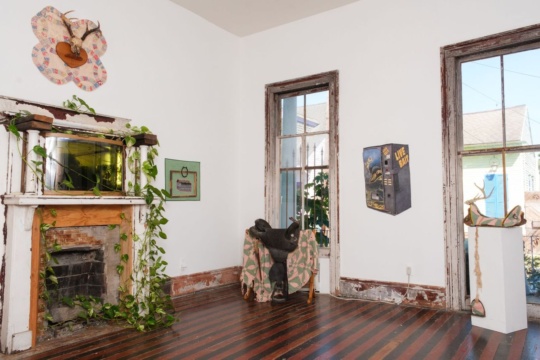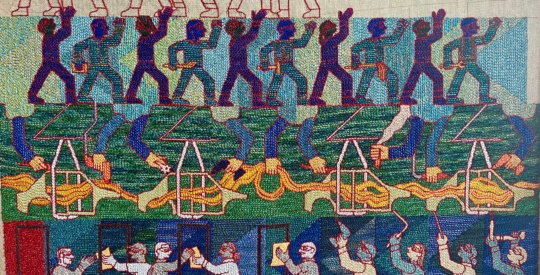
I would like to think that a brewhouse has to be beautiful … People want the beer to come from a good place. – Fritz Maytag of Anchor Brewing in Michael Jackson’s Beer Hunter, 1989
Before the railroad arrived in 1837, the human mark on the forested landscape of what is now Atlanta consisted in only two forms. One was Creek and Cherokee trails meandering along natural ridgelines and waterways. The other was two buildings: a minor military outpost named Fort Peachtree, located near the Creek village of Standing Peachtree along the Chattahoochee shores, and Whitehall Tavern, which resided in what is now known as the West End. The city’s first non-native resident was Charner Humphries, who moved with his family from South Carolina in 1830; by 1835, Humphries had built Whitehall. The tavern, so named for its atypical whitewashed wooden exterior, stood at the crossroads of Newnan and Sandtown Roads, now Lee Street and Ralph David Abernathy Boulevard. Whitehall was a mixed-use community center, incorporating a post office, inn, polling station, gambling venue, and brewpub.

The summation of this historical prelude to the tale of architecture, breweries, and Atlanta is the fact that, arguably, the city’s first building was a tavern and that its distinctive architecture was inherent to its identity. Atlanta’s brewing tradition is older than its founding as a railroad hub. Ron Smith and Mary O. Boyle’s well-documented chronicle of Atlanta and beer reveals that relationship as symptomatic of many national trends, punctuated by outposts of extreme quality. Atlanta’s recent brewery proliferation has been widely covered from the culinary, historical, and entrepreneurial perspectives, mainly by Creative Loafing’s Austin L. Ray. Absent from this textual deluge is architectural criticism, which is likely due to the conspicuous dearth of that written genre in Atlanta as well as a disproportionate ratio of quality to unremarkable works in the built environment. If brewers are to be consistent with experimentation in their craft, then they should apply it to their architecture.

Typically, articles about craft beer focus on the key personnel, the brewery location, and the beers. Novice brewers hone their skills, through hobby, study, or apprenticeships, and may begin larger scale production through contract brewing, the process of using another brewery’s facility to produce their recipes. When they are confident of their own beer quality, have developed favorable reputations, and gained financial backing from friends and banks, they start their own business.
This entrepreneurial inception often involves a realtor, and possibly an architect, in order to secure a brewing space. For an architect, site is a primary departure point for design and the site-selection process sets much of the architectural constraints as a dialogue with the brewer. To this end, Orpheus chose a location adjacent to the Beltline and Piedmont Park for those obvious amenities. Similarly, Eventide and Monday Night sited their properties with the knowledge that they would benefit from the Beltline’s construction, park, and transit corridor development in the future. Burnt Hickory’s converted industrial shed doesn’t equate with their production of quality beers, but their proximity to historic downtown Kennesaw and nearby Proctor Creek (unrelated to the one in Atlanta) provide their already underserved location with architectural potential.
Many brewers choose to fit out their interior themselves, using a design-build contractor for construction. They often disregard the exterior and the poetics of the entrance threshold since a brewer’s principal preoccupation is creating an arena for fermentation. While interior design is the primary focus for most brewers, overall architectural quality derives from a successful design conversation between the building’s interior and exterior, even in the rehabilitation of a nondescript shed. SweetWater’s history presents a particularly relevant case in regards to carrying out an expansion.
The craft revolution in Georgia, of which SweetWater is Atlanta’s most prominent representative, began in response to three separate but related phenomena. The first was Georgia’s 1995 ratification of the homebrewing provision of H.R. 1337, a bill, signed by President Jimmy Carter in 1978, which legalized homebrewing for personal and family use. The second was the Olympics, a high profile event that internationalized Atlanta in an unprecedented manner, bringing a variety of new awareness and talent to the city. The third was Georgia’s 2004 passing of H.B. 647, which allowed beers to be produced and purchased at a maximum of 14% alcohol by volume (ABV), up from the 6% that had been in place since 1935. The combination of these first two resulted in the establishment of thirteen metro area commercial breweries and brewpubs between 1996-97. SweetWater is the only survivor.
Beer, Bricks and Mortar
Related Stories
Reviews
Reviews
Features
Everyday Love by Richard Dial at Institute 193, Lexington
Daniel Fuller reviews the crafted metal chairs reflecting tenderness and the human condition in Everyday Love by Richard Dial at Institute 193, Lexington.
Cora Nimtz: Unlikely Hunter at The Aquarium Gallery and Studio, New Orleans
Virginia Walcott reviews the Southern traditions, stereotypes, and romanticism found in the assemblages of Cora Nimtz: Unlikely Hunter at The Aquarium Gallery and Studio, New Orleans.
Weaving Work: On the Tapestries of Tabitha Arnold
Lina Alam profiles the spiritual allegories and the labor of weaving works created by Chattanooga-based artist Tabitha Arnold.




